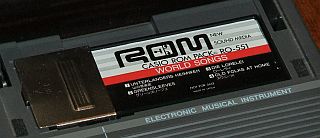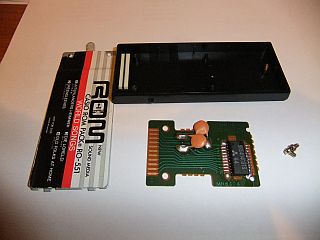<-- Back to the Electronic Home
Keyboards page
The Casio ROM
Pack system was a
method
of storing music
information, rather like modern-day MIDI files,
on
small, interchangable “cassettes” which plugged into a Casio keyboard,
a bit
like you might plug in a Flash memory card today.
The format first
appeared in 1983, and is similar in many respects to the Yamaha Playcard system, which
appeared at
around the same time. Casio made a number of keyboard
models throughout the 1980s and early 1990s that accepted ROM Packs. The most recent ROM Pack I have seen is RO-618K, dated 1993, so the format was in use for at least 10 years - a surprisingly long time.
As well as just
listening to the music, ROM Pack keyboards had various training modes
to teach you to play the tunes, most using flashing LEDs above each key
to guide you - the precursor to the modern Key Lighting feature.
As
their name
suggests, they
were read-only – you could buy various ROM packs with various tunes
pre-loaded,
but you could not record your own data to the packs. Casio
did have
a writable equivalent – the “RAM Pack” – but very few keyboard models
supported the writable packs (in fact, the PT-50
is the only one I know of), and the packs themselves are
extremely
rare.
Thanks to a
hand-written note on the back of a PT-82 manual I recently acquired, I
now know that ROM packs retailed for £7.95 each at Cliff Owen Music in Seven
Kings in around
1986. According to the Bank of England's Inflation Calculator, that equates to about £25 in 2020 - so ROM Packs were not cheap!
Sadly, Cliff Owen Music closed down some time around 2015, and its former site is now occupied by a mobile-phone-repair-cum-hardware shop, and a law firm.
ROM Packs seem to be very robust. Even after nearly 40 years, I have never come across a faulty ROM Pack. Even the apparently-fragile elastomeric (Zebra) contact strip seems very reliable, and I have never had to clean the contacts, even on ROM Packs which have clearly been mistreated. In contrast, Yamaha Playcards can easily be damaged, both physically and by exposure to magnetic fields, rendering them unreadable. Casio's system is definitely the more resilient format.
What Keyboards
support ROM Packs?
The following
Casio keyboard models
support ROM Packs: PT-8, PT-50,
PT-80, PT-82, PT-87, PT-88, PT-180,
PT-280,
PT-380,
PT-480, PT-580, PT-680
MT-18, MT-28,
MT-85, MT-86,
MT-88, MT-800, MT-820, MT-830, CT-800, CT-805,
CT-810, CT-840,
SK-8, SK-8A, KS-03, KS-02 (not to be confused with the SK-2 which is a different keyboard with no ROM Pack support).
The Casio DH-280
and DH-800
Digital Horns (Wind Synthesizers)
also
take
ROM
Packs.
The technology
was never licensed to any other manufacturer, but some ROM
Pack keyboards were sold under the Realistic
Concertmate brand in Tandy (UK) and Radio Shack (US) shops, but
these were simply rebadged Casio models.
I was recently informed that a company called Liwaco
(chiefly known for making hand-held LCD electronic games) also sold
re-badged Casio keyboards in France, and possibly elsewhere as well. A number of these Liwaco clones were ROM
Pack-compatible, and it appears that the ROM Packs themselves supplied
with them were also rebranded as "Liwaco ROM," with a very different label design from Casio-branded
ROMs. See this
blog
post
about
Liwaco's
Casio
clones.
The American piano manufacturer Baldwin also cloned some Casio keyboards, including the ROM-Pack-capable CT-810. This model was rebadged as the Baldwin Discoverer 60, and bundled with a clone of ROM Pack RO-551, labelled as Baldwin BRP-1.
Other manufacturers may also have cloned ROM Pack keyboards. The
Russian company Electronica
cloned the Casio VL-1, naming it the IM-46, so
it seems likely they would have cloned other models as well, and there
could be many others.
What ROM Packs
were available?
I
have created a List of Known Casio ROM
Packs,
based
on
information
from
a
multitude
of
sources, some reliable, others not.
It's almost certainly not complete, and probably isn't very accurate,
but it gives an idea of the sort of music that was available on ROM
Packs.
The
most
common
ROM
pack
is
the
RO-551,
entitled
"World
Songs."
This
contains
four
songs
and seems to
be
the one Casio supplied with most of their ROM pack-compatible
keyboards, so there
are plenty of these around. Other ROM packs are actually quite scarce,
and usually only appear on eBay when bundled with a keyboard.
What does the
music sound like?
Different keyboard
models render the ROM Pack music differently, but there are some audio
examples on the List of Casio ROM Packs.
What's inside a
ROM Pack?
 Surprisingly
little.
It's
just
one
IC
(presumably
a
PROM)
on
a
small
PCB,
with
a
couple of capacitors and an elastomeric (Zebra)
contact strip. Most of the Pack is empty space. I think the pack was
probably designed to be this size so that Casio could fit all the stuff
required for the writable RAM Pack into the same package. The writable
packs didn't seem to catch on, so we're left with a ROM Pack that could
be roughly a quarter of the size it is. Of course, the marketing
department probably had a large say in the dimensions as well.
Surprisingly
little.
It's
just
one
IC
(presumably
a
PROM)
on
a
small
PCB,
with
a
couple of capacitors and an elastomeric (Zebra)
contact strip. Most of the Pack is empty space. I think the pack was
probably designed to be this size so that Casio could fit all the stuff
required for the writable RAM Pack into the same package. The writable
packs didn't seem to catch on, so we're left with a ROM Pack that could
be roughly a quarter of the size it is. Of course, the marketing
department probably had a large say in the dimensions as well.
To
the
right
is
a
picture
of
a
dismantled
ROM
Pack
so
you
can
see for yourself (click the image for a high-resolution
version).
This
particular
pack
(RO-551)
contains
a
Panasonic
MN6404
IC, but other packs may contain
different ICs - I opened an RO-261 and found an OKI M5268. The PCB was
also much thinner, but otherwise identical.
I have not been able to find data
sheets for either of these ICs, and
the only information I can find on the system is in the SK-8 Service
Manual, and is very sketchy and leaves a lot of questions unanswered.
Please
let me know if you can help.
 Surprisingly
little.
It's
just
one
IC
(presumably
a
PROM)
on
a
small
PCB,
with
a
couple of capacitors and an elastomeric (Zebra)
contact strip. Most of the Pack is empty space. I think the pack was
probably designed to be this size so that Casio could fit all the stuff
required for the writable RAM Pack into the same package. The writable
packs didn't seem to catch on, so we're left with a ROM Pack that could
be roughly a quarter of the size it is. Of course, the marketing
department probably had a large say in the dimensions as well.
Surprisingly
little.
It's
just
one
IC
(presumably
a
PROM)
on
a
small
PCB,
with
a
couple of capacitors and an elastomeric (Zebra)
contact strip. Most of the Pack is empty space. I think the pack was
probably designed to be this size so that Casio could fit all the stuff
required for the writable RAM Pack into the same package. The writable
packs didn't seem to catch on, so we're left with a ROM Pack that could
be roughly a quarter of the size it is. Of course, the marketing
department probably had a large say in the dimensions as well. 